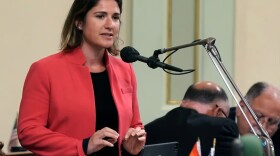You'd think that as a poor country grows wealthier, more of its children would get vaccinated for preventable diseases such as polio, measles and pneumonia.
But a review published in Nature this month offers a different perspective.
"The countries that are really poor get a lot of support for the vaccinations. The countries that are really rich can afford to pay for the vaccines anyway," says Beate Kampmann, director of the Vaccine Centre at the London School of Hygiene & Tropical Medicine and author of the review.
But, she says, "the middle-income countries are in a tricky situation because they don't qualify for support, yet they don't necessarily have the financial resources and stability to purchase the vaccines."
Adrien de Chaisemartin, director of strategy and performance at Gavi, the Vaccine Alliance, agrees: "More and more vulnerable populations live in middle-income countries." Gavi, an international nonprofit that helps buy and distribute vaccines, projects that 70% of the world's under-immunized children will live in middle-income countries by 2030.
Brazil, India, Indonesia and Nigeria were among the 10 countries with the most children who lacked basic vaccinations in 2018 — for example, shots to prevent diphtheria, tetanus and pertussis by age 1. Each of those countries meets the World Bank's definition of a middle-income country: an average annual income (known as the gross national income, or GNI, per capita) between $1,026 and $12,375. In Nigeria alone, 3 million kids are undervaccinated. That's 15% of the world's total of children who lack key vaccinations.
By contrast, vaccination rates can be high in poor countries, according to global health researchers, who say that Gavi has boosted the numbers. Rwanda, for instance, despite having a GNI of $780 per person, now has a near-universal coverage rate for childhood vaccines, on par with some of the wealthiest countries.
But in general, once a country reaches a GNI per capita threshold over $1,580 for three years, support from Gavi tapers off. And despite their improved fortunes, countries don't always choose to fund childhood vaccines.
Angola is among the middle-income countries with the lowest vaccination rates. Diamonds and oil have helped propel the country out of low-income status, and its president is a billionaire. Yet an estimated 30% to 40% of children there did not receive basic vaccines in 2018.
The lag in vaccination rates is caused by any number of reasons. "There's a whole list of middle-income countries, and they're not all the same," says Kampmann.
For example, Sam Agbo, former chief of child survival and development for UNICEF Angola, says Angola's leadership does not fully fund immunization programs. Agbo blames a political system that he says is mired in corruption, financial mismanagement and lots of debt. So it's hard to increase the health care budget. "Primary health care is not sexy," he says. "People are interested in building hospitals and specialized centers rather than investing in preventive care."
Gavi's de Chaisemartin groups Angola with other resource-rich but corruption-plagued countries like the Democratic Republic of Congo, Nigeria, Papua New Guinea and East Timor. "These are countries where the GNI is relatively high because of their oil resources, for the most part, but that doesn't translate into a stronger health system," says de Chaisemartin.
Then there's the matter of cost. Countries that buy vaccines on the open market might pay over $100 a shot.
Public attitudes also play a role. In Brazil, which is on the high end of the middle-income spectrum, an immunization program that once outperformed World Health Organization recommendations has been declining for three years. Jorge Kalil Filho, an immunology professor at the University of Sao Paulo, says public inattention and anti-vaccine campaigns, popular on social media, are undermining progress.
De Chaisemartin says the global health community needs to adjust to an unprecedented global economic shift. "Fifteen years ago, the world was divided between poor countries, where most poor people were living, and high-income countries," says de Chaisemartin. "Now you have a lot of middle-income countries with very poor and vulnerable populations."
Copyright 2019 NPR. To see more, visit https://www.npr.org.






